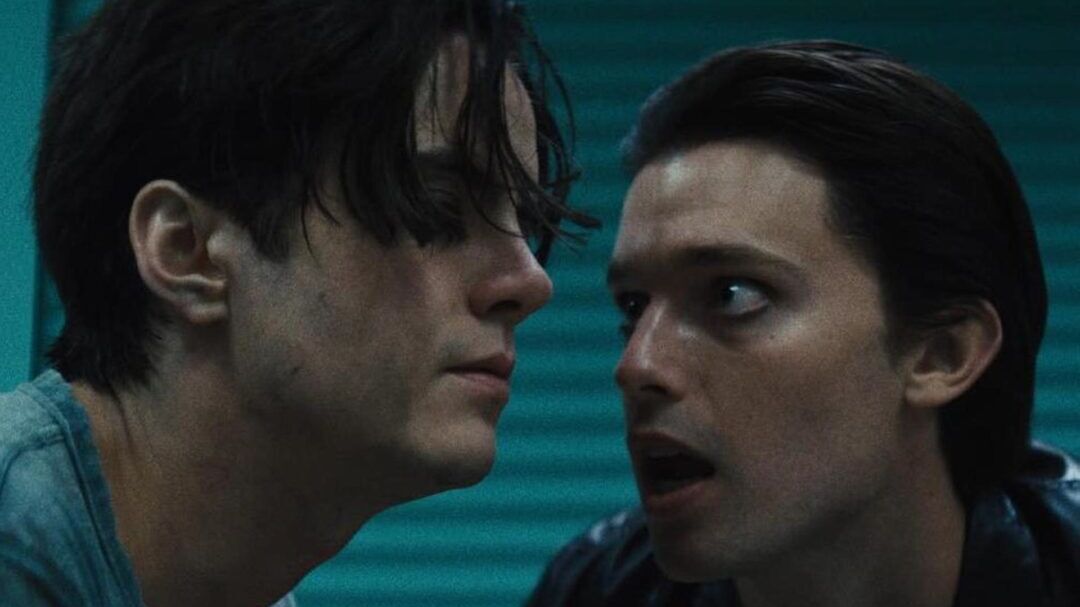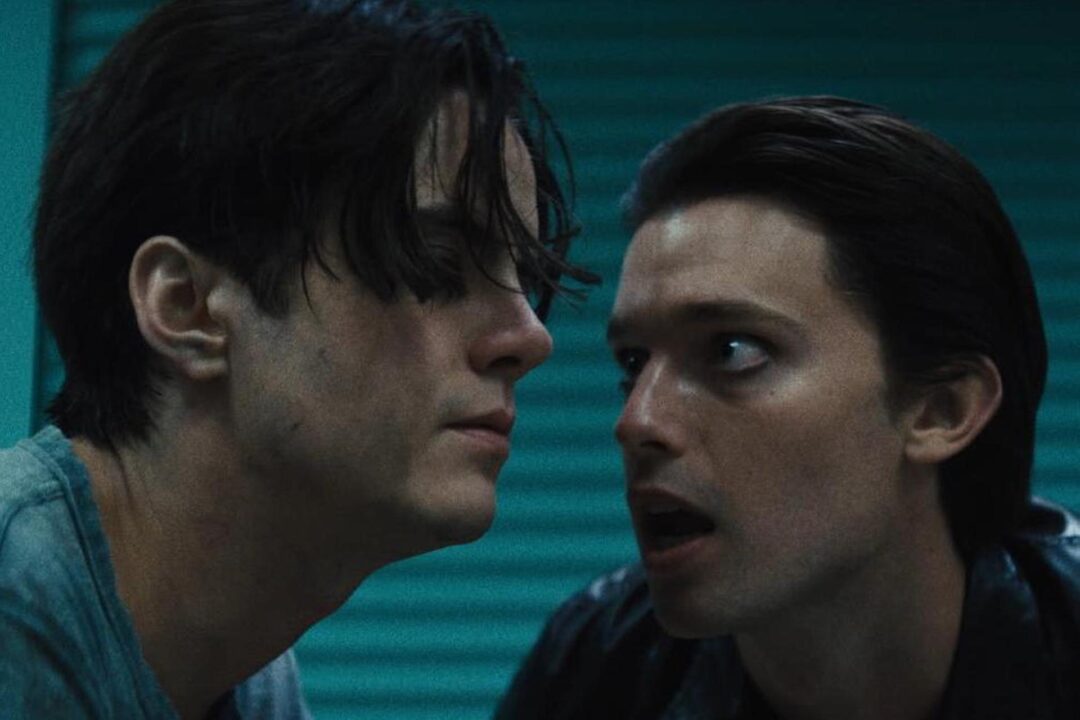Daniel Isn’t Real is a psychological horror film full of the kind of searing imagery and gooey practical effects that send genre fans hearts soaring with the ravens. I could point to an assault by claymation-esque face tentacles as the moment that won me over, but that’s not really true. Because as dazzling as the visuals get, this is a film that captivates not only by landing it’s standout set-pieces, but by imbuing every scene and character with just a little more thoughtfulness, empathy, and panache than required. It’s a triumph of accumulated good calls, of moments where the creative team seeks humanity and social relevance in scenes that could have been pure exploitation.
The film’s prologue snaps the audience to attention by introducing real and supernatural horror all at once. A young boy, Luke, runs from a fight between his parents in NYC, only to come across the aftermath of a mass shooting. As he absorbs the crime, a taller boy with slicked hair invites him to play. This is the eponymous Daniel, Luke’s new, maybe-imaginary friend. At first, Daniel steers Luke away from upsetting realities, beckoning him into a play-world of sword-fighting glory. However, Daniel soon seeks games that draw real blood, suggesting a plan to injure Luke’s mother so disturbing that Luke is forced to lock Daniel, and the selfish impulses he represents, away in an over-sized dollhouse.
While the childhood origins of Daniel are pretty par for the horror course, the film’s electrifying central metaphor becomes clearer by the minute as the adult Daniel and Luke bond. For years, Luke keeps Daniel at bay, growing into a sensitive son and college student. He cares for his affectionate but mentally unstable mother, staying home on nights & weekends to keep her company. This takes a toll on his personal life, as he lacks friends and passion for his studies. When Luke’s therapist (played magnetically by stage & film actor, Chukwudi Iwuji), advises him to get back in touch with repressed parts of himself, Daniel (now a swaggering Patrick Schwarzenegger) re-emerges to invite the tightly-wound Luke to let loose and act selfishly. Soon after, when Luke’s mom (a harrowingly raw Mary Stuart Masterson) engages in self-harm and is hospitalized, Daniel is not so subtly delighted to achieve the pre-eminence in Luke’s life he’s always wanted. Daniel becomes mentor-in-chief, taking Luke on a frantic journey of flirtations, hook-ups, and adventures that allow him to access parts of NYC, and his own personality, he never knew existed.
While Daniel initially operates as a confidante and wingman, convincing Luke he can be and do more with his time, he gradually moves toward pick-up artistry, bullying, misogyny, and violence in his quest to shape Luke in his own image and enact his twisted desires in reality. Sound familiar? It should, because Luke’s arc, while wildly open to interpretation, is stacked with references to the experience of being radicalized into alt-right and incel groups. While Luke does not literally join these groups, his journey of being attracted to an extreme ideology, then repulsed when it shows its true face, is a common arc for lonely young men.
If you’re unfamiliar with these movements, they include many young men who come to Youtube or online forums seeking community, dating advice, or political education. These men often leave with a poisonous view of women and minorities. Reporting on these groups has increased partly because of the violent young men who’ve emerged from the movement. The attackers behind the 2014 Isla Vista shooting, the 2017 Charlottesville Rally car attack and the 2019 Christchurch New Zealand attacks all participated in these online communities. While most young men radicalized online will, of course, not commit mass violence, their views can impact their lives and the lives of those around them profoundly. As the film progresses, Luke fears Daniel might incite him to commit an atrocity like the shooting he witnessed as a child.

This impression I had, that Daniel Isn’t Real was filtering its depths of psychological horror through the distinctly modern experience of internet radicalization, likely had a lot to do with some of the frank personal essays I’ve come across the topic. In one video essay, Faraday Speaks, an ex-adherent of white nationalist ideology, recounts how he adopted extremist thinking after admiring the self-improvement videos of an alt-right leader and subsequently being recommended more radical content by Youtube’s algorithm. His story could be a plot summary for this Daniel Isn’t Real.
“I was looking for a way to fix myself. I knew there was something wrong with me in terms of my depression. And I knew there was something I could do about it.
I got into self-help, neuroscience. I watched all these different types of videos. And to an extent, all of that helped me.
[white supremacist leader’s name redacted] resonated with me because he had shared the same experiences. He had a traumatic childhood. He had issues with his mother. He had issues with the rest of his family. He had issues with the society around him. He was angry with the society around him that it never stepped in and did anything.
I started listening to him more and more. He was charming and intelligent. He had a different message. I wanted so hard to believe that this person who was like me was able to fix themselves and now talk about how much stronger they were, how much better they were. And that really, really got to me.
As I started to fall for this self-help stuff more and more, in my mind I set him up as an authority figure.
And so, to have that sense of stability and belonging, I did the most paradoxical thing you can. I gave myself up to others. And I became the follower. I was brain-washed.” – Caleb, Faraday Speaks (edited for length)
This is precisely the kind of trusting, parasocial relationship with an angry figure that Luke experiences with his supernatural shadow in the film, and like real young men who become closer to online rage culture than real-life friends, it threatens the quality of Luke’s relationships. This becomes apparent in Luke’s romance with Cassie (Sasha Lane), a volatile but perceptive artist who shares his tendencies towards anger but finds an outlet in art. Luke is adorably admiring of her. It’s one of the rare films where the lead is genuinely enamored by his love interest’s talent, not only her looks, and feels major imposter syndrome in approaching her. Daniel convinces him that he is a solid photographer and should exaggerate his background to hit on her. However, when Luke builds a tender connection with Cassie, Daniel perceives a threat to his control. Just as he sought to remove Luke’s mother from the picture, Daniel also plots to remove Cassie, pushing Luke towards transactional sex with less emotional heft. Even Luke’s hook-up, Sophie (Hannah Marks) is a savvy character. She’s a fellow student whose witnessing of Luke/Daniel’s growing toxicity has real consequences for his standing on campus. These over-achievers really went out and made two imperiled horror love interests consequential and memorable, how often have we seen such a thing? It’s small but gratifying to see every horror character make smart decisions. It makes the danger sting all the more.
While radicalization is far from the only lens you can employ to make sense of Luke’s disorienting descent, it’s certainly a fascinating subtext. Some other interpretations have dubbed Daniel Isn’t Real a horror film “about mental health” because of Luke’s mother’s condition and Luke’s search for a diagnosis. Although mental health certainly has a presence that bears discussing, the story never struck me as primarily “about” mental illness. I’m an enormous fan of films that develop a cinematic language for mental illness. From Eighth Grade’s evocation of a young girl’s social anxiety through a forcefully cheerful soundtrack and yellow color palette to Swiss Army Man’s expressive depiction of loneliness & suicidal ideation by way of Paul Dano hiking a literal and figurative forest of emotional obstacles. However, I don’t believe Daniel Isn’t Real is like those films. It’s a caustic cousin to them, more interested in the extreme ideologies that can prey on, and find expression in, the psychologically or socially vulnerable than in depicting a particular mental illness. The film aims to excavate the hollow shapes young men can contort themselves into when they lack emotional support and feel their hopes and hunger for their lives have been frustrated.
I was fortunate to attend a Q&A where director Adam Egypt Mortimer spoke on the development of the film, offering further insight into the influences of the writers and stars. While the script was based on the 2010 novel, In This Way I Was Saved, by Mortimer’s friend and co-screenwriter Brian DeLeeuw, in the 7-year process of developing the film, the creative team strove to find cultural reference points that grounded their story in current concerns. Mortimer confirmed that reporting about radicalized young men was front of mind. Lead actor Miles Robbins and others became very conscious of the narrative parallels to radicalization, and read up on empathetic critical texts like the bell hooks classic on masculinity, The Will to Change. Their consideration paid off in creating a film that contains rich and relevant vein of social commentary and a lot of scares.
Ultimately, Mortimer’s film proves itself darkly literate in horror filmmaking and sociology. There’s so much passion on display from the nuanced characterizations to the playful homages to classics like The Exorcist and Persona. The film is visually resplendent, with colored lights and practical creature effects galore. I’d expect no less from a film backed by Spectrevision, the horror-centric production company behind Panos Cosmatos psychedelic vengeance trip, Mandy, and Ana Lily Amirpour’s comic-book tinged vampire western, A Girl Walks Home Alone at Night. In fact, Daniel Isn’t Real shares key creative personnel with those features, as Girl cinematographer Lyle Vincent shows off his trademark ability to lens alternate worlds on a budget, and Mandy editor Brett W. Bachman reinforces Luke’s frenzied movements with cuts to groaning subways and haunting cosmic voids. Kaet McAnneny’s (Blue Ruin) production design brings the underground tunnels of Brooklyn and the disarray of Luke’s family brownstone to life with an eye for decadent decay.
So, whether the radicalization metaphor I went off on compels you or not, there’s a lot of craft to recommend this. Adventurous viewers will find a captivating depiction of the ancient struggle to find self-worth without falling into self-obsession and to approach others with a healthy desire for connection rather than a festering need to dominate. The imagery and intellect of this story captured me so wholly that I barely feel the need to mention that I might hate the ending. Nevertheless, let’s call this a rave review. I dig 95% of what this film is doing and hope this enthralling title lands distribution soon.
This review was originally posted on June 11, 2019, during the Overlook Film Festival.
Opening this Friday at Alamo Drafthouse Cinema Downtown Los Angeles.
Kailee Andrews
Kailee holds a Communication Arts B.A. from the University of Wisconsin. At 21, she programmed her first film festival for an audience of 4,000+ on campus. Since then, it's been all about sharing the cool arts and crafts of cinema.


